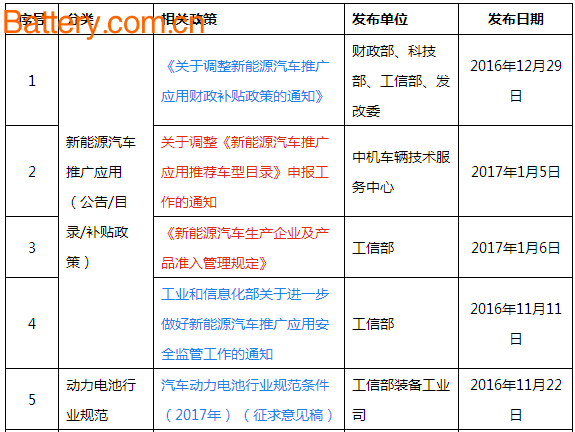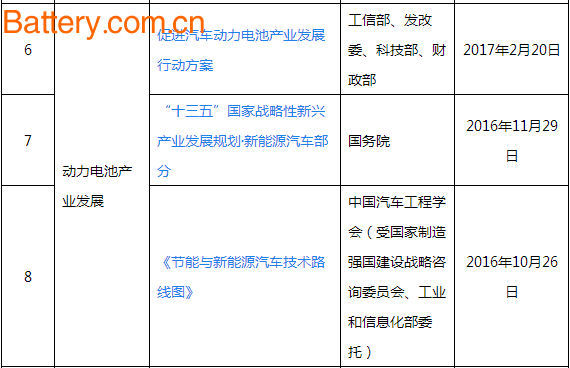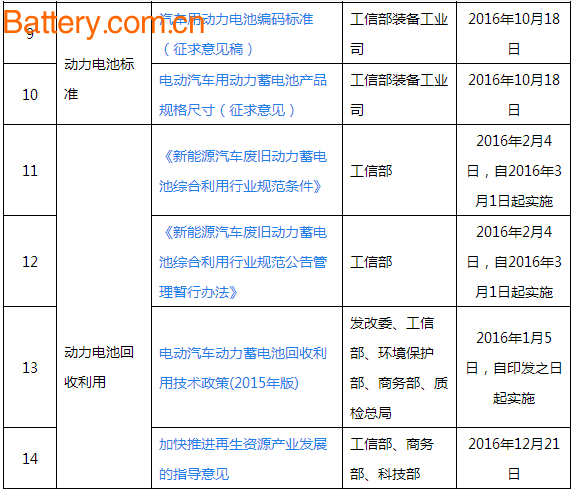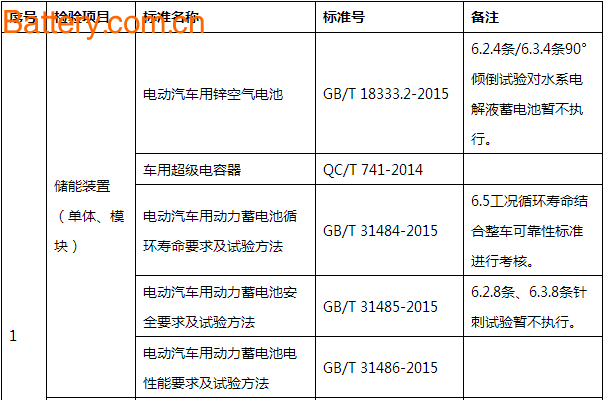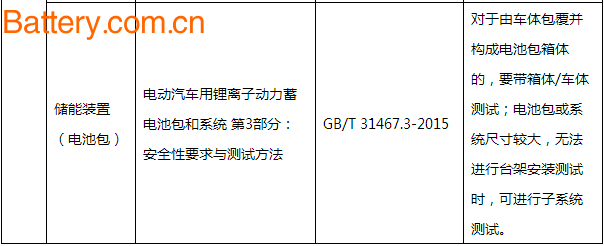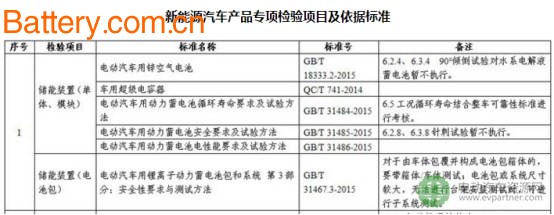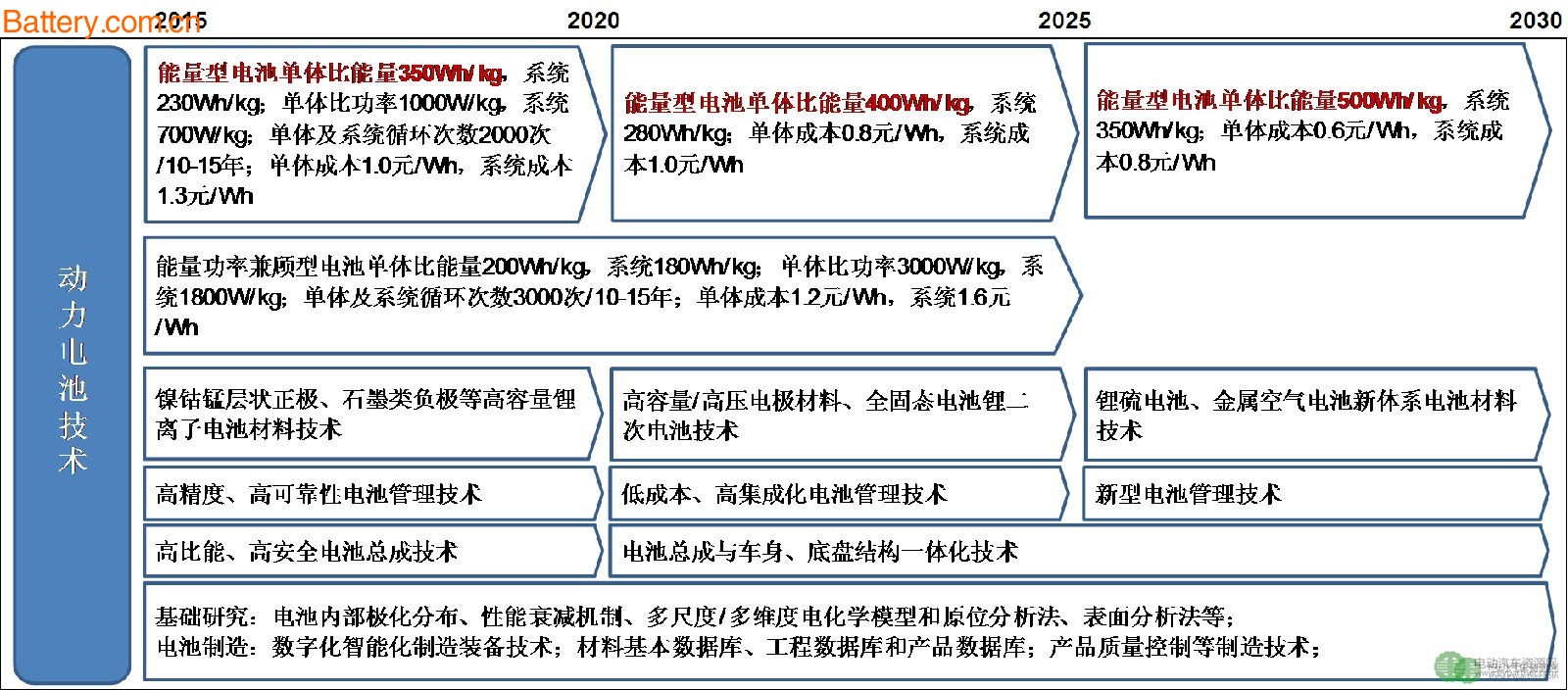The power battery is the heart of new energy vehicles. Relevant national departments attach great importance to the development of power batteries. According to incomplete statistics, since 2016, there have been more than 10 important policies concerning power batteries, covering the promotion and application of new energy vehicles, the regulation of power battery industry, the development of power battery industry, and power batteries. Standard, power battery recycling and other aspects. The following are the policies and main contents of the 14 items related to the new energy vehicle power battery for your reference: 1. Notice on Adjusting the Financial Subsidy Policy for the Promotion and Application of New Energy Vehicles On December 29, 2016, the Ministry of Finance, the Ministry of Science and Technology, the Ministry of Industry and Information Technology, and the Development and Reform Commission jointly issued a notice on adjusting the financial subsidy policy for the promotion and application of new energy vehicles. The subsidy new policy links the subsidy standard to the power battery: (1) The energy density of non-fast charge pure electric bus battery system is higher than 85Wh/kg, and the energy density is 85-95 (inclusive) Wh/kg, 95-115 (inclusive) Wh/kg, 115Wh/kg respectively. Grant 0.8 times, 1 time, 1.2 times subsidy. (2) The fast charge rate of fast charge type pure electric bus is higher than 3C, and the fast charge rate is subsidized by 0.8 times, 1 time and 1.4 times respectively in 3-5C (including), 5-15C (inclusive) and 15C. (3) The mass energy density of the pure electric passenger car power battery system is not less than 90Wh/kg, and the subsidy is 1.1 times higher than 120Wh/kg. (4) The energy density of the power battery system for new energy trucks and special vehicles is not less than 90Wh/kg. Micro-evaluation: In 2017, the subsidy new policy put forward requirements for the energy density of power batteries, and the impact on the development of the power battery industry is obvious. From the list of recommended models for the promotion and application of three new energy vehicles released this year, the energy density of power batteries is gradually increasing. In addition, the number of models supporting high-quality power battery companies in the recommended catalogue has increased significantly, which means that the power battery market is changing and the industry concentration is increasing. ) 2. Notice on Adjusting the Application Work for the Catalogue of Recommended Models for the Promotion and Application of New Energy Vehicles On January 8, 2017, the China Machine Center issued a notice on the adjustment of the “Recommended Models for the Promotion and Application of New Energy Vehiclesâ€. The notice is mainly based on the 2017 subsidy new policy and the adjustment of the recommended catalogue of new energy vehicles. Among them, the contents of the power battery are: (1) The test items for the power battery in the product test item list are: (2) Annex 4 “Test methods for technical indicators related to power batteries and fuel cells (Trial)†specifies the power battery energy density (PED) test method and the maximum charge rate (CR) test method for power batteries (including super capacitors ). Micro-evaluation: As of April 23, 2017, the Ministry of Industry and Information Technology has released a total of 3 recommended models of models, including 1020 models of 105 enterprises. The timely release of the catalogue has played a positive role in the stable development of the new energy vehicle market. 3. "Regulations on the Administration of New Energy Vehicle Manufacturing Enterprises and Products" On January 6, 2017, the Ministry of Industry and Information Technology issued the “Regulations on the Administration of New Energy Vehicle Manufacturing Enterprises and Product Accessâ€. This regulation has improved the entry barriers from the aspects of enterprise design and development capabilities, production capacity, product production consistency assurance capability, after-sales service and product safety assurance capabilities, and strengthened safety supervision requirements, with the aim of effectively improving the quality of new energy vehicle products and Safety level. The new regulations will come into force on July 1, 2017. In the special inspection catalogue of new energy automobile products required by the new regulations, the inspection items related to the power battery are as follows: Micro-evaluation: Corresponding to the entry of new energy vehicle products is the “Road Motor Vehicle Manufacturing Enterprise and Product Announcementâ€. The power battery inspection project for new energy vehicle product access, which will be implemented on July 1, 2017, is consistent with the current power battery inspection project in the new energy vehicle recommended model catalogue. For new energy vehicle products, entering the announcement is the first level, and entering the recommended list is the second level, and to obtain the subsidy, it must also comply with the relevant provisions of the subsidy new policy (such as 30,000 kilometers). 4. Notice of the Ministry of Industry and Information Technology on Further Improving the Safety Supervision and Application of New Energy Vehicles On November 11, 2016, the Ministry of Industry and Information Technology issued the “Notice on Further Improving the Safety Supervision and Application of New Energy Vehiclesâ€, stating that new energy vehicle manufacturers should implement the main responsibility for product quality and safety, and relevant local government departments should do a good job. For safety supervision, industry organizations should give full play to industry self-discipline and technical support. According to the notice, since January 1, 2017, before the introduction of the national standard for electric passenger safety, all newly-produced new energy buses will be temporarily implemented in accordance with the requirements of the “Safety Technical Conditions for Electric Busesâ€. One of the key points of the notice is that the "Electrical Bus Safety Technical Conditions" stipulates that the rechargeable energy storage system needs to pass the thermal runaway test and the thermal runaway expansion test, that is, regardless of the type of power battery, as long as the above two Tests can be applied to electric buses. At this point, the application of the ternary battery on the passenger car was “liftedâ€. Micro-evaluation: Although the application of ternary battery is lifted on passenger cars, from the perspective of new energy buses in the first three batches of 2017, the selected power battery is still dominated by lithium iron phosphate, followed by lithium manganate and titanium. Lithium acid. According to the current situation, ternary batteries are the mainstream in the passenger car field, and lithium iron phosphate is the mainstream in the passenger car field. 5. Automotive power battery industry standard conditions (2017) (draft for comments) On November 22, 2016, the Equipment Industry Department of the Ministry of Industry and Information Technology issued the “Regulations for Automotive Power Battery Industry (2017) (Draft for Comment)â€. When Edition 2017 specification mentioned conditions, enterprise single lithium-ion battery production capacity not less than 80 billion watts, nickel-metal hydride battery single enterprise production capacity of not less than 100 million watts, supercapacitor single enterprise The annual production capacity is not less than 10 GWh. The annual production capacity of the system enterprise is not less than 80,000 sets or 4 billion watt hours. Micro-evaluation: The annual production capacity of power battery cells is not less than 8GWh, which is 40 times the requirement in 2015. However, although the draft of the Exposure has caused strong reaction from the company at the beginning of the release, many power battery companies have expanded their production capacity since 2017 and are approaching 8GWh with action. At present, the power battery industry has begun to show the situation of "high-end production capacity shortage and low-end overcapacity". Some insiders joked: "Everyone thinks that their products are high-end, lack of capacity, and low-end production capacity is others'." Be wary of the risk of overcapacity in power batteries. 6. Promote the development plan of the automotive power battery industry On February 20, 2017, the Ministry of Industry and Information Technology, the Ministry of Development and Reform, the Ministry of Science and Technology, and the Ministry of Finance jointly issued a notice on the “Action Plan for Promoting the Development of Automotive Power Battery Industryâ€. The main goal of the power battery industry in the future is to achieve new lithium by 2020. Ion power battery cell specific energy exceeds 300 watt-hours / kg; system specific energy strives to reach 260 watt-hour / kg, the cost is reduced to 1 yuan / watt hour, the use environment reaches -30 ° C to 55 ° C, can have 3C charging capacity . By 2025, the new system's power battery technology has made breakthroughs, with a monomer specific energy of 500 watt-hours/kg. By 2020, the total capacity of the power battery industry will exceed 100 billion watt-hours, forming a leading enterprise with an international competitiveness in production and sales of more than 40 billion watt-hours. Micro-evaluation: From the above development goals of the power battery industry, it can be seen that in the next few years, the energy density of power batteries will increase significantly, and the cost of power batteries will drop significantly. The realization of these goals requires power battery companies and related units to put technology research and development at an important position. 7. “13th Five-Year†National Strategic Emerging Industry Development Plan·New Energy Vehicles In December 2016, the State Council issued the “13th Five-Year Plan for the Development of National Strategic Emerging Industriesâ€. The main contents of the planning about the field of power batteries are: Building a globally competitive power battery industry chain. Vigorously promote the research and development of power battery technology, focus on breaking through battery grouping and system integration technology, and advance the development of next-generation power batteries and new system power batteries to achieve breakthrough development of battery materials technology. Accelerate the innovation of high-performance, high-reliability power battery production, control and testing equipment, and improve the power battery engineering and industrialization capabilities. Cultivate and develop a group of power battery companies and key materials leading enterprises with continuous innovation capabilities. Promote the use of power battery ladders and establish a power battery recycling system linked by upstream and downstream enterprises. By 2020, the level of power battery technology will be synchronized with the international level, and the scale of production capacity will remain global. 8. "Technology Roadmap for Energy Saving and New Energy Vehicles " On October 26th, 2016, the “Technology Roadmap for Energy Saving and New Energy Vehicles†was released. Its main content is “1+7â€, which is the overall technical roadmap, energy-saving automobile technology roadmap, pure electric and plug-in hybrid vehicles. Technology roadmap, hydrogen fuel cell vehicle technology roadmap, intelligent networked vehicle technology roadmap, automobile manufacturing technology roadmap, automotive power battery technology roadmap, automotive lightweight technology roadmap. Among them, the power battery technology roadmap is: 1 In the near-term, while optimizing the existing system, lithium-ion power battery technology meets the needs of large-scale development of new energy vehicles, while focusing on the development of new lithium-ion power batteries, improving key technologies such as safety, consistency and longevity, and simultaneously launching new technologies. Forward-looking research and development of system power batteries. 2 In the medium and long term, while continuously optimizing and upgrading the new lithium-ion power battery, the company will focus on research and development of new system power batteries, significantly increase energy density, significantly reduce costs, and realize practical and large-scale application of new system power batteries. 9. Automotive power battery coding standard (draft for comments) From October 18, 2016 to October 24, 2016, the Ministry of Industry and Information Technology asked for comments on the "Automobile Power Battery Coding Standard" (draft for comments). This standard specifies the basic principles, coding objects, code structure and data carrier of automotive power battery coding. It is applicable to the whole life cycle of the production, sales, use, maintenance, recycling, cascade utilization and recycling of automotive power battery products. And management. 10. Specifications and specifications of power battery products for electric vehicles (Consultation) From October 18, 2016 to October 24, 2016, the Ministry of Industry and Information Technology asked for comments on "Specifications and Dimensions of Power Battery Products for Electric Vehicles" (Draft for Comment). This standard specifies the power battery unit, module and standard box size specifications. It is suitable for lithium ion batteries and metal hydride nickel batteries for electric vehicles. Other types of batteries are referred to. 11. "Standard Conditions for Comprehensive Utilization of Waste Energy Storage Battery for New Energy Vehicles" On February 4, 2016, the Ministry of Industry and Information Technology issued the “Regulations for the Comprehensive Utilization of Waste Energy Storage Battery for New Energy Vehiclesâ€. The conditions regulate the layout of waste power battery comprehensive utilization enterprise and project construction conditions, scale, equipment and technology, comprehensive utilization of resources and energy consumption, environmental protection requirements, product quality and vocational education, product quality and vocational education, etc. It will take effect on March 1st. 12. Interim Measures for the Administration of the Announcement of the Standardization of the Comprehensive Utilization of Waste Power Batteries for New Energy Vehicles On February 4, 2016, the Ministry of Industry and Information Technology issued the Interim Measures for the Administration of the Regulations on the Comprehensive Utilization of Waste Energy Storage Battery for New Energy Vehicles. According to the Interim Measures, the Ministry of Industry and Information Technology and the competent departments of industry and information technology of provinces, autonomous regions and municipalities directly under the Central Government are responsible for the dynamic management of enterprises that meet the "Regulations". The Ministry of Industry and Information Technology entrusts relevant professional organizations to assist in the management of announcements. Work, the company applies on a voluntary basis. The Interim Measures also clarified the application and verification, review and announcement, supervision and management, etc., and will be implemented as of March 1, 2016. 13. Technical Policy for Recycling and Utilization of Electric Vehicle Power Battery (2015 Edition) On January 5, 2016, the National Development and Reform Commission, the Ministry of Industry and Information Technology, the Ministry of Environmental Protection, the Ministry of Commerce, and the General Administration of Quality Supervision, Inspection and Quarantine jointly issued the "Technical Policy for Recycling and Utilization of Electric Vehicles for Electric Vehicles (2015 Edition)", designing, producing and recycling electric vehicle power batteries. Specific provisions have been made for the main body, the use of the ladder, and the recycling. 14. Guiding Opinions on Accelerating the Development of Recycling Resources Industry On December 21, 2016, the Ministry of Industry and Information Technology, the Ministry of Commerce, and the Ministry of Science and Technology issued the "Guiding Opinions on Accelerating the Development of the Recycling Resources Industry." The opinion pointed out that the demonstration work on recycling and utilization of new energy power batteries will focus on the development of new energy vehicles in Beijing, Tianjin, Hebei, the Yangtze River Delta and the Pearl River Delta, and select some cities to carry out pilot demonstrations of recycling of new energy vehicles' power batteries through the Internet of Things. Informatization means such as big data, establish a traceability management system, support the establishment of a universal and economical recycling model, and carry out research, product development and demonstration applications of cascade utilization and reuse technologies. METALLIZED LAMINATION FILMS-PET
PET Metallised Thermal Laminating film is made by PET Metallic Film and EVA. We use extrusion coating process to combine the two layers. Metallized PET Thermal Lamination Film has single side corona treated, It makes the package look nice, precious and high value. It has high oxidation resistance and moisture barrier. It's a durable, cost-effective replacement for foil in a typical paper.
PET Metallised Thermal Laminating Film,Metallized PET Thermal Lamination Film, Metallic PET Lamination Film, Metallized PET Thermal Film, PET Metallised Film, PET Metallized Thermal Film, Gold and Silver Metallized PET Thermal Lamination Film GR (SHANDONG) NEW MATERIAL CO., LTD , https://www.grfilmcn.com